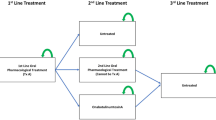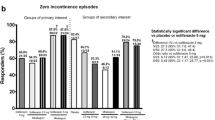Abstract
Objectives
Overactive bladder may cause significant discomfort to patients. The standard therapy for overactive bladder includes behavioural therapy and sometimes medication. Recently, a new medication (solifenacin 5 and 10 mg) was developed for treatment of overactive bladder. The objective of this study was to assess the cost utility of solifenacin 5 and 10 mg for overactive bladder.
Methods
We developed a Markov model to estimate the cost per quality adjusted life years (QALY) over a period of 12-months. Model parameters were based on randomized clinical trials for solifenacin 5 and 10 mg. Data on utility scores were taken from the literature.
Results
The incremental cost per QALY for solifenacin 5 mg and solifenacin 10 mg compared with placebo were £17,602 and £24,464 respectively. Sensitivity analyses showed that these results were robust to changes of relevant input data.
Conclusion
Solifenacin 5 and 10 mg are cost-effective treatments in patients with overactive bladder.

Similar content being viewed by others
References
Cardozo L, Castro-Diaz D, Gittelman M et al (2006) Reductions in overactive bladder-related incontinence from pooled analysis of phase III trials evaluating treatment with solifenacin. Int Urogynecol J Pelvic Floor Dysfunct 17:512–519. doi:10.1007/s00192-005-0058-6
Hennessey A, Robertson NP, Swingler R et al (1999) Urinary, faecal and sexual dysfunction in patients with multiple sclerosis. J Neurol 246:1027–1032. doi:10.1007/s004150050508
Johannesson M, O’Conor RM, Kobelt-Nguyen G et al (1997) Willingness to pay for reduced incontinence symptoms. Br J Urol 80:557–562
Kobelt G, Jonsson L, Mattiasson A (1998) Cost-effectiveness of new treatments for overactive bladder: the example of tolterodine, a new muscarinic agent: a Markov model. Neurourol Urodyn 17:599–611. doi :10.1002/(SICI)1520-6777(1998)17:6<599::AID-NAU4>3.0.CO;2-J
Milsom I, Abrams P, Cardozo L, Roberts RG et al (2001) How widespread are the symptoms of an overactive bladder and how are they managed? A population-based prevalence study. BJU Int 87:760–766. doi:10.1046/j.1464-410x.2001.02228.x
Nabi G, Cody JD, Ellis G, Herbison P et al (2006) Anticholinergic drugs versus placebo for overactive bladder syndrome in adults. Cochrane Database Syst Rev CD003781
Sonnenberg FA, Beck JR (1993) Markov models in medical decision making: a practical guide. Med Decis Making 13:322–338. doi:10.1177/0272989X9301300409
Acknowledgement
This study was funded by an unrestricted fund of Yamanouchi Europe, The Netherlands.
Author information
Authors and Affiliations
Corresponding author
Rights and permissions
About this article
Cite this article
Hakkaart, L., Verboom, P., Phillips, R. et al. The cost utility of solifenacin in the treatment of overactive bladder. Int Urol Nephrol 41, 293–298 (2009). https://doi.org/10.1007/s11255-008-9448-2
Received:
Accepted:
Published:
Issue Date:
DOI: https://doi.org/10.1007/s11255-008-9448-2




